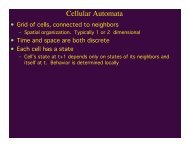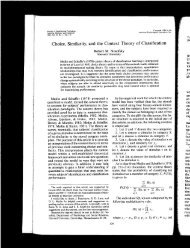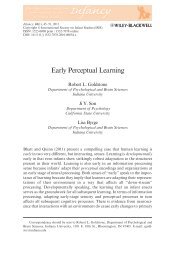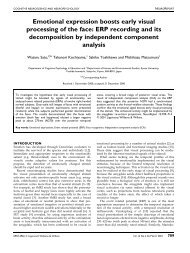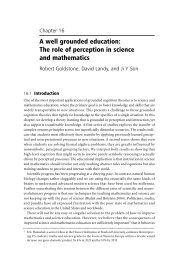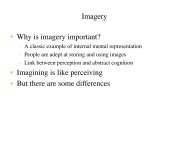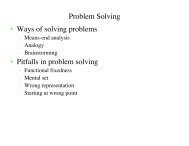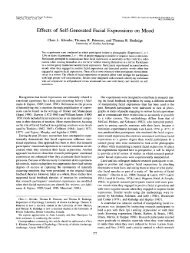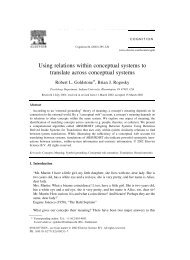the psychology of learning and motivation - Percepts and Concepts ...
the psychology of learning and motivation - Percepts and Concepts ...
the psychology of learning and motivation - Percepts and Concepts ...
You also want an ePaper? Increase the reach of your titles
YUMPU automatically turns print PDFs into web optimized ePapers that Google loves.
The Ubiquitous Patterns <strong>of</strong> Incorrect Answers to Science Questions 2551997; van der Linden, 2008), or to detect cheating (van der Linden &van Krimpen-Stoop, 2003). However, for <strong>the</strong> questions used in thisstudy, students answered in patterned ways, <strong>and</strong> thus <strong>the</strong>y are notguessing (e.g., see Heckler et al., 2010).In sum, some patterns in responses to science questions may arise fromlower level implicit decision criteria (e.g., answer quickly) ra<strong>the</strong>r thanfrom some higher level conceptual underst<strong>and</strong>ing. The influence <strong>of</strong> thislower level process can be significant enough to mask a student’s overallability to determine <strong>the</strong> correct answer. The hypo<strong>the</strong>sis that students willtend to base <strong>the</strong>ir answer on <strong>the</strong> plausible information that is processed <strong>the</strong>fastest makes testable predictions about response times as well as responsechoices. Not only is <strong>the</strong>re some existing evidence to support this hypo<strong>the</strong>sis,but <strong>the</strong>re are also many possibilities <strong>of</strong> testing it fur<strong>the</strong>r by designingexperiments that include <strong>the</strong> capture <strong>of</strong> response time data as well asresponse choice data.7.2. High salience <strong>of</strong> irrelevant cues: attentional <strong>learning</strong>Competition can also be manifested in terms <strong>of</strong> allocation <strong>of</strong> attention.When two or more cues are present, it is <strong>of</strong>ten <strong>the</strong> case that one <strong>of</strong> <strong>the</strong>mcaptures most <strong>of</strong> <strong>the</strong> attention. This phenomenon <strong>of</strong> cue competition isfundamental to a wide range <strong>of</strong> <strong>learning</strong> <strong>and</strong> behavior. For example,decades <strong>of</strong> studies in category <strong>learning</strong> have identified two major factorsthat determine which cues are learned <strong>and</strong> which are ignored among amultitude <strong>of</strong> competing cues in <strong>the</strong> environment: learners tend to learncues that are relatively salient, predictive, or both (e.g., see Edgell, Bright,Ng, Noonan, & Ford, 1992; Hall, 1991; Trabasso & Bower, 1968). Thereare a number <strong>of</strong> successful models that can explain <strong>the</strong> trade-<strong>of</strong>f between<strong>the</strong> salience <strong>and</strong> predictiveness <strong>of</strong> a dimension in terms <strong>of</strong> learnedattention(e.g., Kruschke, 2001; Mackintosh, 1975). In our recent work, collaborators<strong>and</strong> I have provided evidence that when low-salient cues repeatedlycompete with high-salient cues, <strong>the</strong> low-salient cues are learned to beignored, even if <strong>the</strong>y are more predictive than <strong>the</strong> high-salient cues(Heckler, Kaminski, & Sloutsky, 2008; 2011). This learned inattention tolow-salient yet predictive information may contribute to <strong>the</strong> students’difficulties in correctly answering science questions <strong>and</strong> <strong>learning</strong> scienceconcepts.How can attentional <strong>learning</strong> lead to incorrect answering on sciencequestions? Science concepts involve highly predictive cues, but <strong>the</strong>sepredictive cues can be <strong>of</strong> relatively low salience. For example, <strong>the</strong> acceleration<strong>of</strong> an object uniquely predicts <strong>the</strong> net force on that object, yetacceleration is <strong>of</strong>ten less salient than velocity (e.g., Schmerler, 1976), <strong>and</strong>students <strong>of</strong>ten infer <strong>the</strong> net force on an object from <strong>the</strong> velocity <strong>of</strong> <strong>the</strong>object ra<strong>the</strong>r than its acceleration (e.g., Clement, 1982; Halloun &




